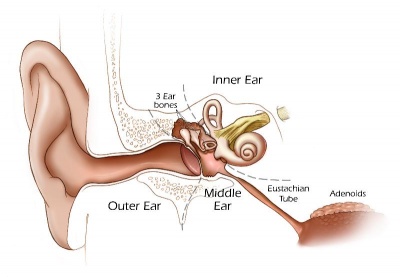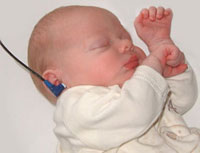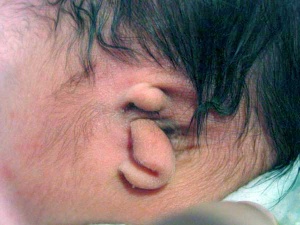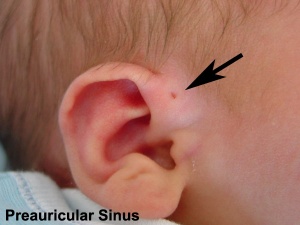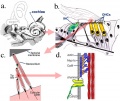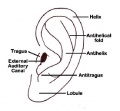Sensory - Hearing Abnormalities: Difference between revisions
| Line 124: | Line 124: | ||
===Search Pubmed=== | ===Search Pubmed=== | ||
'''Search Pubmed:''' [http://www.ncbi.nlm.nih.gov/sites/entrez?db=pubmed&cmd=search&term=Hearing%20Development%20Abnormalities Abnormalities] | '''Search Pubmed:''' [http://www.ncbi.nlm.nih.gov/sites/entrez?db=pubmed&cmd=search&term=Hearing%20Development%20Abnormalities Abnormalities] | [http://www.ncbi.nlm.nih.gov/entrez/query.fcgi?db=pubmed&cmd=search&term=Middle%20ear%20ossicular%20anomalies Middle ear ossicular anomalies] | [http://www.ncbi.nlm.nih.gov/entrez/query.fcgi?db=pubmed&cmd=search&term=familial%20expansile%20osteolysis familial expansile osteolysis] | [http://www.ncbi.nlm.nih.gov/entrez/query.fcgi?db=pubmed&cmd=search&term=cholesteatoma cholesteatoma] | | ||
==Additional Images== | ==Additional Images== | ||
Revision as of 17:35, 5 June 2010
Introduction
How and why do things go wrong in development? Developing of hearing requires a complex origin, organisation, and timecourse means that abnormal development of any one system can impact upon the development of hearing. There are many different abnormalities of hearing development that can result in hearing loss and can broadly be divided into either conductive or sensorineural loss. These abnormalities can have genetic, environmental or unknown origins. In addition, abnormalities of the external ear (position and structure) is used as a clinical diagnostic tool for developmental abnormalities in other systems.
In Australia, there is now an early postnatal screening of neonatal hearing as part of a NSW State Wide Infant Screening Hearing (SWISH) Program using Automated Auditory Brainstem Response (AABR).
| Abnormality Links: abnormal development | abnormal genetic | abnormal environmental | Unknown | teratogens | ectopic pregnancy | cardiovascular abnormalities | coelom abnormalities | endocrine abnormalities | gastrointestinal abnormalities | genital abnormalities | head abnormalities | integumentary abnormalities | musculoskeletal abnormalities | limb abnormalities | neural abnormalities | neural crest abnormalities | placenta abnormalities | renal abnormalities | respiratory abnormalities | hearing abnormalities | vision abnormalities | twinning | Developmental Origins of Health and Disease | ICD-11 | ||
|
Some Recent Findings
- Review - The etiology of otosclerosis[1] "Otosclerosis is a common form of hearing loss characterized by abnormal bone remodeling in the otic capsule. It is a complex genetic disease, caused by a combination of genetic and environmental factors. During the past decade, several attempts have been made to identify factors for otosclerosis."
Inner Ear Abnormalities
Common cavity, severe cochlear hypoplasia
Cholesteatoma
Epithelium trapped within skull base in development, erosion of bones: temporal bone, middle ear, mastoid
Middle Ear Abnormalities
Rare and can be part of first arch syndrome.
Fixation of the middle ear ossicles Malleus, Incus and Stapes Middle ear abnormalities (ossicular anomalies) are rare and can be part of first arch syndrome.
- familial expansile osteolysis
- malleus/incus fixation
- absence of the long process of the incus
- congenital fixation of stapes (stapes anchored to oval window)
- failure of annular ligament development
- cholesteatoma
Familial Expansile Osteolysis (FEO)
A rare congenital (autosomal dominant, 18q21.1-q22) disorder similar to Paget’s disease of bone. Osteolytic lesions occur in all bones (mainly long bones) causing medullar expansions and lead eventually to middle ear and jaw abnormalities.
Daneshi A, Shafeghati Y, Karimi-Nejad MH, Khosravi A, Farhang F. Hereditary bilateral conductive hearing loss caused by total loss of ossicles: a report of familial expansile osteolysis. Otol Neurotol. 2005 Mar;26(2):237-40.
Malleus/Incus Fixation
Wehrs RE. Congenital absence of the long process of the incus. Laryngoscope. 1999 Feb;109(2 Pt 1):192-7.
Congenital Fixation of Stapes
In this condition the stapes is anchored to oval window often by growth of bone around the stapes (otosclerosis). Surgicallly treated by stapedectomy, where the bone and stapes is removed and replaced by a prosthesis.
Seidman MD, Babu S. A new approach for malleus/incus fixation: no prosthesis necessary. Otol Neurotol. 2004 Sep;25(5):669-73.
Cholesteatoma
Squamous epithelium that has been trapped within the skull base during development (congenital) and also occurs in an acquired form. The presence of this abnormality leads to erosion of the bones (temporal bone, middle ear, or mastoid) in which the epithelium is embedded.
Outer Ear Abnormalities
Several genetic effects and syndromes, Environmental Effects
- Microtia - abnormally small external ear
- Preauricular sinus - occurs in 0.25% births, bilateral (hereditary) 25-50%, unilateral (mainly the left), duct runs inward can extend into the parotid gland, Postnatally sites for infection
Fetal Alcohol Syndrome
- Postion- Lower or uneven height, "railroad track” appearance, curve at top part of outer ear is under-developed, folded over parallel to curve beneath
Congenital Deafness
Sensorineural - cochlear or central auditory pathway Conductive - disease of outer and middle ear
Sensorineural
Cochlear or central auditory pathway
- Hereditary
- recessive- severe
- dominant- mild
- can be associated with abnormal pigmentation (hair and irises)
- Acquired
- rubella (German measles), maternal infection during 2nd month of pregnancy, vaccination of young girls
- cytomegalovirus [2]
- streptomycin
- antibiotic
- thalidomide
Conductive
Disease of outer and middle ear
- produced by otitis media with effusion, is widespread in young children.
- temporary blockage of outer or middle ear
Newborn Hearing Screening
In Australia, there is now an early postnatal screening of neonatal hearing as part of a NSW State Wide Infant Screening Hearing (SWISH) Program using Automated Auditory Brainstem Response (AABR).
- Very low birthweight infants and universal newborn hearing screening in a developing country[3]
Links: NSW Statewide Infant Screening - Hearing (SWISH) Program
Bionic Ear
The "Cochlear Implant" was pioneered in development by Professor Graeme Clark (1960s, Australia).[4] It consists of an array of electrodes implanted within cochlea, that directly electrically stimulate the auditory nerve fibres.
- Young children with cochlear implants compared with children with normal hearing.[5]
References
Online Textbooks
- Clinical Methods 63. Cranial Nerves IX and X: The Glossopharyngeal and Vagus Nerves | The Tongue | 126. The Ear and Auditory System | An Overview of the Head and Neck - Ears and Hearing | Audiometry
- Health Services/Technology Assessment Text (HSTAT) Bethesda (MD): National Library of Medicine (US), 2003 Oct. Developmental Disorders Associated with Failure to Thrive
- Search Bookshelf hearing development
Reviews
- The International Journal of Developmental Biology Vol. 51 Nos. 6/7 (2007) Ear Development
Articles
Search Pubmed
Search Pubmed: Abnormalities | Middle ear ossicular anomalies | familial expansile osteolysis | cholesteatoma |
Additional Images
External Links
- Embryo Images - Hearing
- NIDCD - Balance Disorders
- NSW Health - NSW Statewide Infant Screening - Hearing (SWISH) Program
- American Academy of Audiology - American Academy of Audiology | In Memoriam: Judy Gravel
Glossary Links
- Glossary: A | B | C | D | E | F | G | H | I | J | K | L | M | N | O | P | Q | R | S | T | U | V | W | X | Y | Z | Numbers | Symbols | Term Link
Cite this page: Hill, M.A. (2024, May 1) Embryology Sensory - Hearing Abnormalities. Retrieved from https://embryology.med.unsw.edu.au/embryology/index.php/Sensory_-_Hearing_Abnormalities
- © Dr Mark Hill 2024, UNSW Embryology ISBN: 978 0 7334 2609 4 - UNSW CRICOS Provider Code No. 00098G
